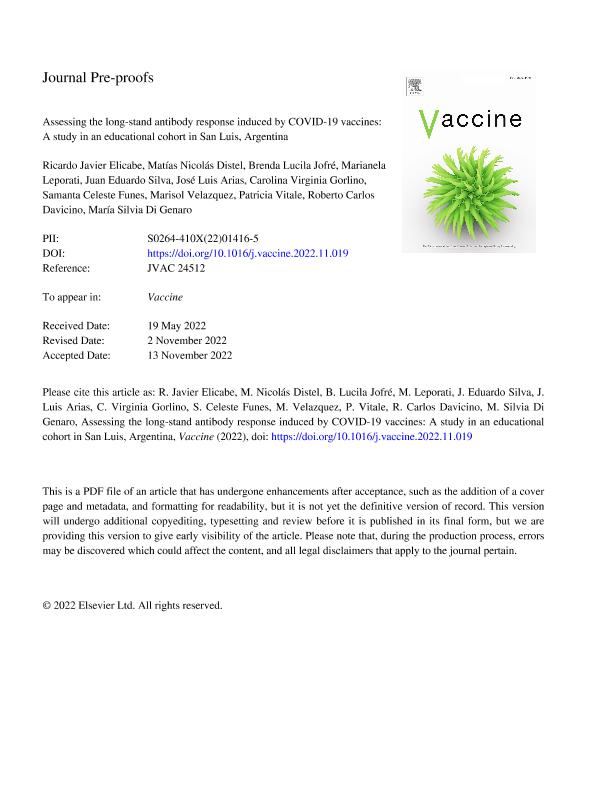Artículo
Assessing the long-stand antibody response induced by COVID-19 vaccines: A study in an educational cohort in San Luis, Argentina
Eliçabe, Ricardo Javier ; Distel, Matias Nicolas
; Distel, Matias Nicolas ; Jofré, Brenda Luicila
; Jofré, Brenda Luicila ; Leporati, Marianela
; Leporati, Marianela ; Silva, Juan Eduardo
; Silva, Juan Eduardo ; Arias, Jose Luis
; Arias, Jose Luis ; Gorlino, Carolina Virginia
; Gorlino, Carolina Virginia ; Funes, Samanta Celeste
; Funes, Samanta Celeste ; Velazquez, Marisol; Vitale, Patricia; Davicino, Roberto Carlos
; Velazquez, Marisol; Vitale, Patricia; Davicino, Roberto Carlos ; Di Genaro, Maria Silvia
; Di Genaro, Maria Silvia
 ; Distel, Matias Nicolas
; Distel, Matias Nicolas ; Jofré, Brenda Luicila
; Jofré, Brenda Luicila ; Leporati, Marianela
; Leporati, Marianela ; Silva, Juan Eduardo
; Silva, Juan Eduardo ; Arias, Jose Luis
; Arias, Jose Luis ; Gorlino, Carolina Virginia
; Gorlino, Carolina Virginia ; Funes, Samanta Celeste
; Funes, Samanta Celeste ; Velazquez, Marisol; Vitale, Patricia; Davicino, Roberto Carlos
; Velazquez, Marisol; Vitale, Patricia; Davicino, Roberto Carlos ; Di Genaro, Maria Silvia
; Di Genaro, Maria Silvia
Fecha de publicación:
11/2022
Editorial:
Elsevier
Revista:
Vaccine
ISSN:
0264-410X
Idioma:
Inglés
Tipo de recurso:
Artículo publicado
Clasificación temática:
Resumen
Background: Although there has developed an increased interest in the vaccines BNT1622b2 (Pfizer/BioNTech), mRNA-1273 (Moderna/NIAID), and ChAdOx1 nCoV-19 (AstraZeneca/University of Oxford), there are still few reports describing the immune response induced by different vaccine platforms in real-world settings of low-income countries. Here, we proposed to analyse the humoral immune response elicited by the primary vaccines used in Argentina from July-December 2021. Methods: Anti-SARS-CoV-2-Spike-RBD IgG and neutralising antibodies were assayed by ELISA in a total of 871 serum samples obtained from 376 volunteers from an educational staff. The individuals were vaccinated with BBIBP-CorV (Sinopharm), ChAdOx1 nCoV-19 (AstraZeneca/University of Oxford, AZ), Gam-COVID-Vac (Sputnik V, SpV) or combined vaccines (mostly SpV and mRNA-1273, Moderna). The antibody response was analysed several days after the initial vaccination (20, 40, 120 and 180 days). Results: After receiving at least one dose of the COVID-19 vaccine, we detected 93.34% of seroprevalence. Previously SARS-CoV-2 infected showed higher antibody concentrations compared with naïve vaccinees. Six months after the initial vaccination, combined vaccination induced higher anti-SARS-CoV-2 antibody levels than the other vaccines in naïve volunteers. However, we did not find differences in the neutralising responses after any vaccine from naïve vaccines or between the naïve and previously infected volunteers on day 120 after vaccination. Conclusions: Our long-term analysis of volunteers from the educational system provides data in a real-world context, showing the benefits of a boost dose still in previously infected volunteers, and suggesting the advantages of a heterologous prime-boost schedule.
Palabras clave:
ASTRAZENECA
,
BBIBP-CORV
,
CHADOX1NCOV-19
,
GAM-COVID-VAC
,
SINOPHARM
,
SPUTNIK V
,
COVID-19
Archivos asociados
Licencia
Identificadores
Colecciones
Articulos(IMIBIO-SL)
Articulos de INST. MULTIDICIPLINARIO DE INV. BIO. DE SAN LUIS
Articulos de INST. MULTIDICIPLINARIO DE INV. BIO. DE SAN LUIS
Citación
Eliçabe, Ricardo Javier; Distel, Matias Nicolas; Jofré, Brenda Luicila; Leporati, Marianela; Silva, Juan Eduardo; et al.; Assessing the long-stand antibody response induced by COVID-19 vaccines: A study in an educational cohort in San Luis, Argentina; Elsevier; Vaccine; 41; 2; 11-2022; 476-485
Compartir
Altmétricas



